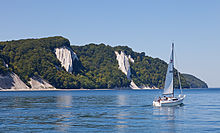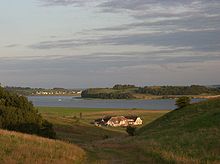Rügen
![]()
This article is about the Baltic Sea island of Rügen. For the former administrative district of the same name see Landkreis Rügen, for other meanings see Rügen (disambiguation).
Rügen is the largest and, with around 63,200 inhabitants, also the most populous island in Germany. It lies off the Baltic coast of Vorpommern and belongs to the district of Vorpommern-Rügen in the state of Mecklenburg-Vorpommern.
The "gate" to the island of Rügen is the Hanseatic city of Stralsund, Rügen is connected to the mainland by the Rügen Dam and the Rügen Bridge across the two-kilometre-wide Strelasund. The island has an area of 926 km², a maximum length of 52 km (from south to north) and a maximum width of 41 km in the south. Due to the ice age, Rügen is very rich in hills and water.
The coast is strongly indented by numerous sea bays and lagoons (Bodden and Wieke) as well as protruding peninsulas and headlands. In June 2011, UNESCO awarded the Jasmund National Park on the island of Rügen the status of World Natural Heritage Site, known for its vast beech population and white chalk cliffs.
Rügen is home to the central capital Bergen, the harbour town Sassnitz, the princely residence Putbus, the country town Garz and the Baltic resorts Binz, Sellin, Göhren, Baabe, Thiessow, Breege and Altefähr. Rügen is a popular holiday destination, above all thanks to its diverse landscape and nature, the thatched and spa architecture with many architectural monuments, the growing range of hospitality and cultural offerings, and the long, fine-sand bathing beaches. The island recorded a good 6 million overnight stays in 2014, slightly less than the German island record holder Sylt. The traffic situation on Rügen is considered problematic for residents and holidaymakers, mainly due to frequent traffic jams and a lack of alternatives such as bus, rail, ferry and air connections.
The Latin and historical name of the island of Rügen is Rugia. The adjective for referring to the island is rügisch, also rüganisch or Rügener. The islanders are called Rügener or Rüganer.
Geology
Together with the Danish island of Møn on the opposite side of the Baltic Sea to Rügen, Rügen was once part of a larger plateau of chalk limestone that had been pushed to the earth's surface by tectonic movements. By far the largest part of this land mass has disappeared again through erosion and faulting, leaving the two islands with their characteristic chalk cliffs.
Geography
The northern part of the Greifswald Bodden, the Rügischer Bodden, is a large bay in the south of Rügen. The island of Vilm is located off the coast here. At the western end of the bay stretches the peninsula Zudar with the southernmost point of Rügen (Palmer Ort); at the eastern end the peninsula Mönchgut, again strongly indented, rises into the sea. This peninsula ends in the east at Cape Nordperd near Göhren and in the south at Cape Südperd near Thiessow. In the west of the Mönchgut peninsula, a five-kilometre-long narrow headland, the Reddevitzer Höft, divides the two bays Having and Hagensche Wiek.
The northeast of the island of Rügen is formed by the Jasmund peninsula, which is connected to the core island "Muttland" by the spit Schmale Heide between Binz-Prora and Sassnitz-Mukran and a railway and road embankment near Lietzow. The Schmale Heide separates the outer bay of the Prorer Wiek from the Kleiner Jasmunder Bodden. On the peninsula Jasmund are with the Piekberg (161 m above sea level) the highest elevation and with the Königsstuhl, a 118-meter-high chalk cliff of the Stubbenkammer, the most prominent landmark of the island of Rügen. Another spit, the Schaabe, connects Jasmund with the peninsula Wittow in the north of Rügen. The Schaabe in turn separates the outer bay of the Tromper Wiek from the Great Jasmund Bodden. The Wittow peninsula and the long and narrow Bug peninsula to the west are separated from the main part of Rügen by the Rassower Strom, the Breetzer Bodden and the Breeger Bodden. The peninsula Wittow closes to the north with Cape Arkona. Barely one kilometre to the northwest at 54° 41' n. Br. is the northernmost point of Mecklenburg-Vorpommern. In front of this cliff (Gellort), the Siebenschneiderstein - the fourth largest erratic boulder in Rügen - lies on the shore.
The northwest and west side of the island of Rügen is also strongly indented, but somewhat flatter. The islands of Hiddensee and Ummanz as well as the smaller islands of Öhe, Liebitz and Heuwiese are offshore. Due to sand erosion and sand accumulation in the Baltic Sea, the shipping channels north and south of the island of Hiddensee must be constantly dredged, otherwise Hiddensee would "grow together" with Rügen within a few years.
The middle of Rügen is only slightly hilly, the area is mainly characterized by agriculture. East of the city of Bergen on Rügen, 90 m above sea level are reached (Rugard with observation tower) and in the southeastern hill country of Granitz 107 m above sea level. The soil on Rügen is very fertile and productive, especially on Wittow, the granary of the island. In addition, there are large cabbage growing areas. Rügen is littered with many erratic blocks, of which the 22 largest are legally protected geotopes (see also: erratic blocks around and on Rügen).

enlarge and show information about the picture
![]()
Panoramic view over Rügen from the Granitz hunting lodge
Locations
The central place and middle centre of Rügen is the town of Bergen. Basic centres are the towns of Binz, Garz, Putbus, Sagard, Samtens, Sassnitz and Sellin / Baabe. Other municipalities with over one thousand inhabitants (as of December 2013) are Altefähr near Stralsund, Dranske, Gingst, Poseritz and Wiek. The city of Stralsund acts as the main centre for the island of Rügen.
Many places on Rügen are of tourist importance, especially near attractions such as Cape Arkona (Putgarten), castles, cultural events (Ralswiek) and near water. Traditional houses with thatched roofs as well as plaster, fieldstone and brick facades are often typical for rural places, while sophisticated spa architecture prevails in the time-honoured seaside resorts.
· ![]()
Bergen on the island of Rügen
· 
Vitt on Cape Arkona
· .jpg)
Primary school Garz
·
Sassnitz
·
Rügenpark in Gingst
·
Altefähr near Stralsund

Jasmund National Park with the famous chalk cliff Königsstuhl

Lagoon landscape Mönchgut in the southeast of Rügen
Search within the encyclopedia
.JPG)

,_by_Klugschnacker_in_Wikipedia_(14).JPG)